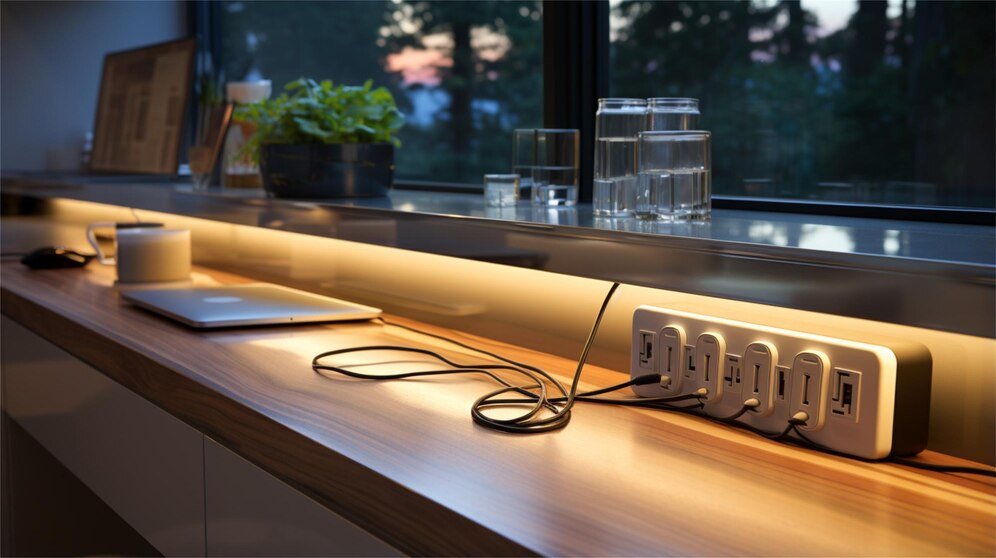In today’s technology-driven world, a kitchen does more than food preparation—it’s a hub for social gatherings, a space for kids’ homework, and often a place for multitasking that includes digital devices. Integrating a hidden kitchen charging station is a modern solution to keep your devices powered without cluttering countertops or detracting from the aesthetic of your kitchen design. Here’s how you can create a seamless and functional hidden charging station in your kitchen.
Understanding the Basics of a Hidden Charging Station
A hidden kitchen charging station is essentially a dedicated spot where you can charge your electronic devices, such as smartphones, tablets, laptops, and other tech, without these gadgets being in plain sight. The goal is to maintain the kitchen’s clean and organized look while providing practical utility.
Planning Your Hidden Charging Station
1. Assess Your Needs: Determine which devices you will regularly charge and their power requirements. This will help you decide on the number of charging ports and the type of power supply you need (USB, traditional outlets, etc.).
2. Choose the Right Location: Select a location in your kitchen that is easily accessible yet can be discreet. Common places include inside a drawer, a cabinet, or a pantry. The location should also be near a power source or allow for easy installation of new wiring.
3. Consider the Space: Ensure that the chosen location has enough space to accommodate the devices and any necessary charging docks or cables.
Designing the Charging Station
- Selecting Materials: Use materials that match or complement your existing kitchen cabinetry and hardware. This continuity will help maintain the seamless look when the charging station is closed.
- Customizing the Drawer or Cabinet: Convert an existing drawer or cabinet into a charging station by adding dividers to hold devices in place and prevent them from getting damaged while stowed away. Consider using soft liners to protect the devices and reduce noise when opening and closing.
- Electrical Considerations: Work with a professional electrician to install outlets inside the drawer or cabinet. Opt for outlets that include USB ports to save space and allow for a variety of devices to be charged. Ensure that all wiring complies with local electrical codes and safety standards.
- Ventilation: To prevent overheating, ensure your hidden charging station is well-ventilated. This can be achieved through strategic gaps in the drawer or by installing a small cooling fan if many devices will be charged simultaneously.
Integrating Smart Technology
- Smart Outlets and Hubs: Install smart outlets or a hub system that can be controlled via smartphone apps. These allow you to turn off the power when not in use, saving electricity and adding an extra layer of safety.
- Wireless Charging Pads: Consider embedding wireless charging pads if the surface allows. These can charge devices without the need for cables and support a cleaner setup.
- Cable Management: Use cable organizers to keep charging cables neat and prevent them from tangling. This makes the space more functional and visually tidy.
Aesthetic Touches for a Seamless Look
- Hidden Handles: Use push-to-open mechanisms or recessed handles for the drawer or cabinet housing the charging station. These features keep the exterior smooth and in line with the rest of your cabinetry.
- Matching Finishes: Ensure that all visible components, like the interior of the drawer or cabinet, match the finish of other kitchen elements. This detail maintains aesthetic consistency even when the charging station is open.
- Lighting: Install subtle LED lighting inside the charging station for functionality and a modern touch. This helps in easily connecting devices in low light conditions.
Finalizing Your Hidden Kitchen Charging Station
- Testing: Before finalizing the installation, test the setup with all the devices you plan to charge. This ensures everything fits comfortably and works as intended.
- Adjustments: Based on the test, make any necessary adjustments to the layout, wiring, or design to improve functionality or appearance.
- Professional Help: Although many aspects of this project can be DIY, don’t hesitate to hire professionals for electrical work or custom cabinetry modifications. This ensures safety and high-quality results.
Customization Options for Enhanced Usability
1. Modular Components: Consider modular interior components that can be adjusted or replaced depending on the devices you need to charge. This flexibility allows you to customize the charging station to fit new devices or change its layout as your needs evolve.
2. Security Features: For those storing expensive devices or personal data, integrating security features such as locks on the charging drawer or cabinet can provide peace of mind. Biometric locks (such as fingerprint sensors) can offer a high level of security while maintaining easy access for authorized users.
3. Accessibility Enhancements: For households with elderly or disabled members, ergonomics and accessibility can be improved by positioning the charging station at an accessible height. Consider mechanisms that allow the drawer to extend fully and smoothly or cabinets that open with minimal effort.
4. Power Saving Modes: Incorporate timers or energy-efficient switches that automatically turn off power to the station after a set period of inactivity. This feature not only saves energy but also extends the lifespan of your electronic devices by avoiding overcharging.
Maintenance and Upkeep
1. Regular Checks: Regularly check and maintain the charging station to ensure it continues to function efficiently. This includes checking for loose wires, ensuring that the outlets are functioning, and that the drawer mechanisms are smooth.
2. Cleaning Tips: Keeping the charging station clean is crucial, especially since it’s located in the kitchen. Ensure that the station is dust-free and clean from any kitchen spills. Use materials in the build that are resistant to stains and easy to wipe down without damaging the interior.
3. Updating Technology: As charging technology evolves, consider updating your charging station to accommodate new charging standards or faster charging capabilities. This might involve replacing older outlets with newer ones that feature updated technology.
4. Seasonal Adjustments: Depending on the climate and the season, the internal conditions of the charging station may need adjustments, particularly regarding humidity control. Small silica gel packets can help control moisture, which is especially important in damp climates.
Conclusion
By incorporating these additional customization and maintenance aspects into your hidden kitchen charging station, you ensure its longevity and continued relevance in your household. Not only does this station serve a functional purpose, but it also enhances the overall design and utility of your kitchen, making it a smart addition to any modern home.





